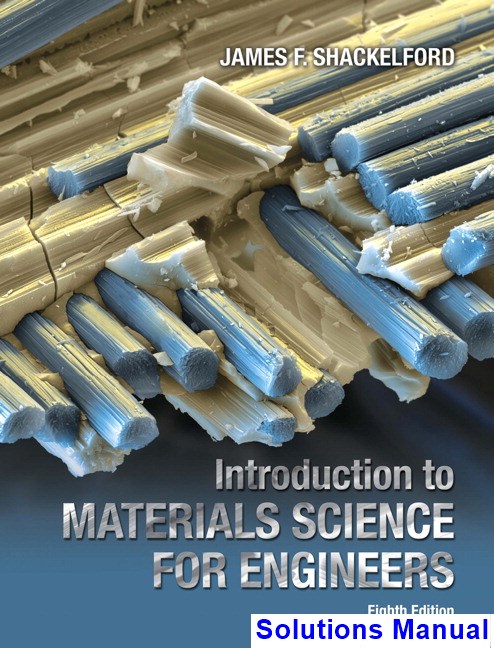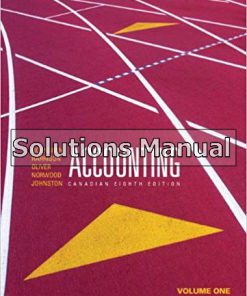Introduction to Materials Science for Engineers 8th Edition Shackelford Solutions Manual
$26.50$50.00 (-47%)
Introduction to Materials Science for Engineers 8th Edition Shackelford Solutions Manual.
You may also like
Introduction to Materials Science for Engineers 8th Edition Shackelford Solutions Manual

Product details:
- ISBN-10 : 0133826651
- ISBN-13 : 978-0133826654
- Author: James Shackelford (Author)
This book is intended for use in a first course in Materials Sciences and Engineering taught in the departments of materials science, mechanical, civil and general engineering. It is also a suitable reference for mechanical and civil engineers and machine designers.
Introduction to Materials Science for Engineers provides balanced, current treatment of the full spectrum of engineering materials, covering all the physical properties, applications and relevant properties associated with engineering materials. It explores all of the major categories of materials while also offering detailed examinations of a wide range of new materials with high-tech applications.
Table contents:
1 Materials for Engineering 1
1.1 The Material World 1
1.2 Materials Science and Engineering 2
1.3 Six Materials That Changed Your World 3
Steel Bridges Introducing Metals 3
Lucalox Lamp Introducing Ceramics 5
Optical Fiber Introducing Glasses 9
Nylon Parachutes Introducing Polymers 11
Kevlar-Reinforced Tiresâ Introducing Composites 13
Silicon Chips Introducing Semiconductors 14
1.4 Processing and Selecting Materials 15
1.5 Looking at Materials by Powers of Ten 17
Part I The Fundamentals
2 Atomic Bonding 23
2.1 Atomic Structure 23
2.2 The Ionic Bond 29
Coordination Number 33
2.3 The Covalent Bond 41
2.4 The Metallic Bond 47
2.5 The Secondary, or van der Waals, Bond 49
2.6 Materials– The Bonding Classification 52
3 Crystalline Structure–Perfection 59
3.1 Seven Systems and Fourteen Lattices 59
3.2 Metal Structures 63
3.3 Ceramic Structures 67
3.4 Polymeric Structures 76
3.5 Semiconductor Structures 77
3.6 Lattice Positions, Directions, and Planes 81
3.7 X-Ray Diffraction 93
4 Crystal Defects and Noncrystalline Structure–Imperfection 104
4.1 The Solid Solution– Chemical Imperfection 104
4.2 Point Defects– Zero- Dimensional Imperfections 110
4.3 Linear Defects, or Dislocations–One-Dimensional Imperfections 112
4.4 Planar Defects–Two-DimensionalImperfections 114
4.5 Noncrystalline Solids–Three-Dimensional Imperfections 118
5 Diffusion 126
5.1 Thermally Activated Processes 126
5.2 Thermal Production of Point Defects 130
5.3 Point Defects and Solid-State Diffusion 132
5.4 Steady-State Diffusion 142
5.5 Alternate Diffusion Paths 146
6 Mechanical Behavior 152
6.1 Stress Versus Strain 153 Metals 153
Ceramics and Glasses 164
Polymers 168
6.2 Elastic Deformation 173
6.3 Plastic Deformation 174
6.4 Hardness 181
6.5 Creep and Stress Relaxation 185
6.6 Viscoelastic Deformation 192
Inorganic Glasses 194
Organic Polymers 196
Elastomers 199
7 Thermal Behavior 210
7.1 Heat Capacity 210
7.2 Thermal Expansion 213
7.3 Thermal Conductivity 216
7.4 Thermal Shock 221
8 Failure Analysis and Prevention 227
8.1 Impact Energy 228
8.2 Fracture Toughness 233
8.3 Fatigue 237
8.4 Nondestructive Testing 246
8.5 Failure Analysis and Prevention 249
9 Phase Diagrams–Equilibrium Microstructural Development 257
9.1 The Phase Rule 258
9.2 The Phase Diagram 261
Complete Solid Solution 262
Eutectic Diagram with No Solid Solution 265
Eutectic Diagram with Limited Solid Solution 267
Eutectoid Diagram 270
Peritectic Diagram 271
General Binary Diagrams 275
9.3 The Lever Rule 281
9.4 Microstructural Development During Slow Cooling 285
10 Kinetics– Heat Treatment 304
10.1 Time–The Third Dimension 304
10.2 The TTT Diagram 309
Diffusional Transformations 310
Diffusionless (Martensitic) Transformations 311
Heat Treatment of Steel 316
10.3 Hardenability 324
10.4 Precipitation Hardening 327
10.5 Annealing 331
Cold Work 331
Recovery 332
Recrystallization 332
Grain Growth 334
10.6 The Kinetics of Phase Transformations for Nonmetals 335
Part II Materials and Their Applications
11 Structural Materials– Metals, Ceramics, and Glasses 349
11.1 Metals 349
Ferrous Alloys 350
Nonferrous Alloys 356
11.2 Ceramics and Glasses 360
Ceramics–Crystalline Materials 361
Glasses–Noncrystalline Materials 362
Glass- Ceramics 364
11.3 Processing the Structural Materials 366
Processing of Metals 367
Processing of Ceramics and Glasses 374
12 Structural Materials–Polymers and Composites 383
12.1 Polymers 383
Polymerization 384
Structural Features of Polymers 389
Thermoplastic Polymers 393
Thermosetting Polymers 394
Additives 396
12.2 Composites 398
Fiber-Reinforced Composites 398
Aggregate Composites 404
Property Averaging 406
Mechanical Properties of Composites 412
12.3 Processing the Structural Materials 417
Processing of Polymers 417
Processing of Composites 420
13 Electronic Materials 429
13.1 Charge Carriers and Conduction 430
13.2 Energy Levels and Energy Bands 434
13.3 Conductors 440
Thermocouples 443
Superconductors 444
13.4 Insulators 452
Ferroelectrics 453
Piezoelectrics 456
13.5 Semiconductors 460
Intrinsic, Elemental Semiconductors 461
Extrinsic, Elemental Semiconductors 466
Compound Semiconductors 478
Processing of Semiconductors 482
Semiconductor Devices 485
13.6 Composites 495
13.7 Electrical Classification of Materials 496
14 Optical and Magnetic Materials 504
14.1 Optical Materials 505
Optical Properties 508
Optical Systems and Devices 518
14.2 Magnetic Materials 526
Ferromagnetism 530
Ferrimagnetism 536
Metallic Magnets 540
Ceramic Magnets 546
15 Materials in Engineering Design 557
15.1 Material Properties–Engineering Design Parameters 557
15.2 Selection of Structural Materials–Case Studies 562
Materials for Hip-and Knee-Joint Replacement 563
Metal Substitution with Composites 566
15.3 Selection of Electronic, Optical, and Magnetic Materials–Case
Studies 567
Light-Emitting Diode 568
Glass for Smart Phone and Tablet Touch Screens 571
Amorphous Metal for Electric-Power Distribution 572
15.4 Materials and Our Environment 573
Environmental Degradation of Materials 573
Environmental Aspects of Design 589
Recycling 592
People also search:
introduction to materials science for engineers
what is material science and engineering all about
energy science and engineering syllabus
introduction to materials science and engineering callister
what is basic engineering science
how is science used in engineering












